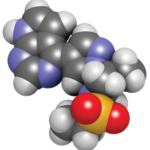EULAR 2023 (MILAN)—Over the past several years, a plethora of new treatments for patients with rheumatoid arthritis (RA) has emerged, while older treatments still play a large role in therapy for many patients. At the EULAR 2023 session titled Rheumatoid Arthritis: New Small Molecules and Old DMARDs, several speakers presented abstracts comparing different treatment effects across different patient populations.
Malignancy

Dr. Schaefer
Martin Schaefer, PhD, epidemiology and healthcare research, German Rheumatism Research Center (DRFZ), Berlin, discussed incident malignancies in real-world patients with RA receiving conventional Dr. Schaefer synthetic disease-modifying anti-rheumatic drugs (csDMARDs), targeted synthetic DMARDs (tsDMARDs) and biologic therapies.
Dr. Schaefer and colleagues analyzed patients from the RABBIT biologic registry and calculated incidence rates of malignancies, excluding non-melanoma skin cancer, for all patients.1 Incidence rates were also calculated specifically for patients who fit the inclusion criteria for the ORAL Surveillance trial, which compared tofacitinib with adalimumab, namely for those aged 50 and older with one or more cardiovascular risk factors. Incidence rates for malignancy in these groups were then compared with patients receiving tumor necrosis factor-alpha (TNFα) inhibitor therapy.
A total of 151 incident malignancies were reported for the five years of registry data reviewed, and incidence rates were comparable across all treatments, with 7 to 11 events per 1,000 patient-years. Among the selected patients who met inclusion criteria for ORAL Surveillance, incidence rates were higher, with a rate of 13.2 events per 1,000 person-years in patients receiving Janus kinase (JAK) inhibitor therapy. In adjusted analyses, the risk for malignancy of patients receiving JAK inhibitor therapy, rituximab, interleukin-6 (IL-6) or csDMARD therapy did not significantly differ from the malignancy risk of those patients receiving TNFα inhibitor therapy. This is important given the concerns prompted by the ORAL Surveillance trial, which found a possible increased risk of malignancy associated with tofacitinib.
MACE with JAK Inhibitors
Romain Aymon, BA, MS, statistician, Hôpitaux Universitaires de Genève, Switzerland, spoke on the topic of major adverse cardiovascular events (MACE) in real-world patients with RA being started on treatment with JAK inihibitor therapy compared with other biologic agents.
Aymon et al. looked at data from more than 50,000 treatment initia- tions in more than 34,000 patients.2 The mean follow-up period was 2.8 years, and patients from 14 RA registries from around the world were included in the study. MACE incidence rates were calculated and attributed to treatment if the event occurred up to three months after treatment cessation for any of these medications. (Note: For rituximab, events up to one year after treatment cessation were considered attributable to the treatment.) Using adjusted Poisson regression analysis, no significant difference in MACE was found between JAK inhibitor and TNFα inhibitor therapy; nor was there a difference between patients receiving all other biologic DMARDs vs. those receiving a TNFα inhibitor. This held true even when isolating patients who met criteria for the ORAL Surveillance study.
The authors concluded that, in this real-world study, patients receiving JAK inhibitor therapy did not have a significantly higher risk of MACE than patients treated with a TNFα inhibitor, although they note other registries need to be included in the future to increase statistical power.
Glucocorticoid Bridging
Lotte van Ouwerkerk, PhD candidate, Leiden University Medical Center, Netherlands, discussed how initial glucocorticoid bridging in RA may affect glucocorticoid use over time.3
Data were analyzed from the BeST, CareRA and COBRA trials, which had study arms with and without use of glucocorticoid bridging in patients, in addition to csDMARD therapy. Glucocorticoid-bridging schedules were planned for a minimum of 34–36 weeks across these studies. In this individual patient data meta-analysis, the researchers compared glucocorticoid use between bridgers and non-bridgers at 12, 18 and 24 months from baseline and used this as the primary outcome.
The results indicated that compared with non-bridgers, after the glucocorticoid bridging therapy period, which lasted an average of 35 weeks, bridgers had an increased risk of using glucocorticoids at the 12-month mark from baseline, but not at the 18- or 24-month intervals. The cumulative glucocorticoid dose, including the planned bridging period, was significantly higher for bridgers than non-bridgers, translating into a difference of 4 mg a day for two years. Bridgers did have a more rapid decrease in their Disease Activity Score-28 (DAS28) in the first six months of therapy than non-bridgers, but there were no differences in DAS28 or number of flares after the end of the bridging schedules. Thus, the benefits and risks of glucocorticoid bridging should be weighed carefully and considered for each individual patient.
Zoster
The final presentation was given by Kevin Winthrop, MD, MPH, professor of infectious diseases and ophthalmology, School of Medicine, Oregon Health & Science University (OHSU), Portland, and a professor of public health at the OHSU-PSU School of Public Health. The study that Dr. Winthrop discussed sought to assess the immunogenicity of adjuvanted recombinant zoster vaccine (RZV; Shingrix) in patients with RA on background methotrexate treated with 15 mg of upadacitinib once daily.4,5
Researchers evaluated patients aged 50 and older from the phase 3 SELECT-COMPARE trial. The patients were on stable doses of upadacitinib and background methotrexate for eight weeks or longer before their first vaccination dose and four weeks or longer after the second vaccination dose. The primary end point for the study was the proportion of patients with a humoral response to RZV as defined by fourfold or greater increase in pre-vaccination concentration of anti-glycoprotein E titer levels at week 16.
In evaluating more than 90 patients, Dr. Winthrop and colleagues found that 88% of patients achieved a satisfactory humoral response to RZV at week 16, and age and use of glucocorticoids did not result in negative effects on the response. These study results are particularly important because the risk of shingles infection has been shown to be increased in patients treated with JAK inhibitor therapy. Thus, proper use of RZV in these patients is essential.
In Sum
The session highlighted many of the hot topics related to RA medications, both old and new. There continues to be great advancement in our understanding of these treatment modalities and how best to balance benefits and risks of therapy. With ongoing research, continued progress will be made toward ensuring the ideal outcomes for every patient with RA.
Jason Liebowitz, MD, is an assistant professor of medicine in the Division of Rheumatology at Columbia University Vagelos College of Physicians and Surgeons, New York.
References
- Ytterberg SR, Bhatt DL, Mikuls TR, et al. Cardiovascular and cancer risk with tofacitinib in rheumatoid arthritis. N Engl J Med. 2022 Jan;386(4):316–326.
- Aymon R, Mongin D, Bergstra SA, et al. Incidence of major adverse cardiovascular events in patients with rheumatoid arthritis treated with JAK- inhibitors compared to bDMARDS: Data from an international collaboration of registries (the ‘JAK-POT’ study). [abstract OP0219] Ann Rheum Dis. 2023;82:143–145.
- Van Ouwerkerk L, Verschueren P, Boers M, et al. Initial glucocorticoid bridging in rheumatoid arthritis: Does it affect glucocorticoid use over time? [abstract OP0220] Ann Rheum Dis. 2023;82:145.
- Winthrop KL, Curtis JR, Lindsey S, et al. Herpes zoster and tofacitinib: Clinical outcomes and the risk of concomitant therapy. Arthritis Rheumatol. 2017 Oct;69(10):1960–1968.
- Winthrop KL. The emerging safety profile of JAK inhibitors in rheumatic disease. Nat Rev Rheumatol. 2017 Apr;13(5):320.


